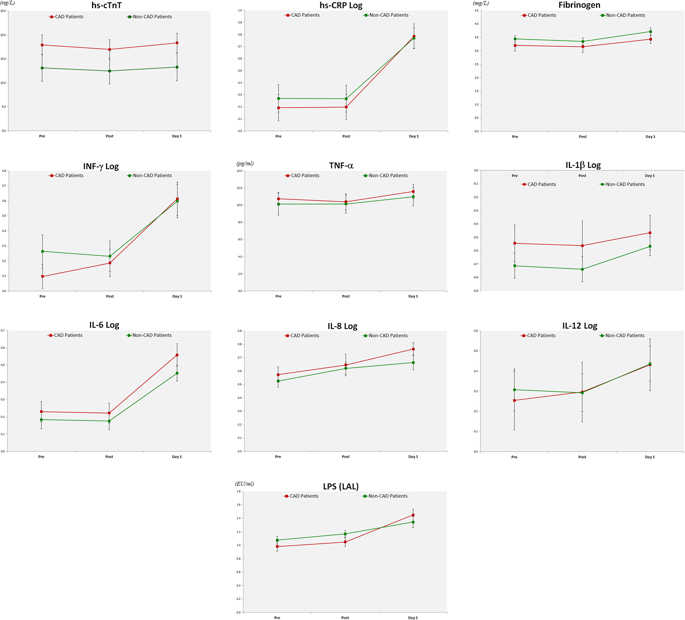BDJ Open Pub Date : 2019-07-09 , DOI: 10.1038/s41405-019-0018-8 K M Habbab 1, 2 , F D'Aiuto 1 , M A Habbab 2 , S R Porter 1

|
Objectives
The aim of this study was to characterize biological changes following dental extractions in patients with and without coronary artery disease (CAD).
Materials and methods
Forty-five patients (36 males and 9 females) referred for dental extraction underwent treatment and provided blood samples before, immediately after, and 24 h after the procedure. A broad array of biomarkers was employed to assess myocardial injury (highly sensitive troponin T, hs-TnT), bacterial burden (LPS endotoxin activity), and systemic inflammation (CRP, fibrinogen, IFN-γ, IL-1β, IL-6, IL-8, IL-10, IL-12, and TNF-α).
Results
Dental extraction in patients with and without CAD was associated with rises in hs-TnT (p = 0.013), hs-CRP (p < 0.001), fibrinogen (p = 0.005), endotoxin activity (p < 0.001), IFN-γ (p < 0.001), IL-6 (p < 0.001), IL-8 (p = 0.011), and IL-12 (p < 0.001) at 24 h compared with immediately post procedure. Changes in systemic inflammation and endotoxin activity were more evident in those with hs-TnT rise.
Conclusions
Simple dental extractions may cause mild increase in hs-TnT, indicating minor myocardial injury in both patients with and without CAD. Acute systemic inflammation and endotoxemia could represent a possible link between invasive dental treatment and increased risk of acute cardiovascular events. These findings indicate that invasive dental treatment (as simple as a single dental extraction) may impact negatively on clinical outcomes in dental patients, especially those with CAD.
中文翻译:

冠状动脉疾病患者拔牙后心肌损伤的相关分子标志物
目标
本研究的目的是描述患有和未患有冠状动脉疾病 (CAD) 的患者拔牙后的生物学变化。
材料和方法
45 名接受拔牙手术的患者(36 名男性和 9 名女性)接受了治疗,并在手术前、手术后立即和手术后 24 小时提供了血液样本。使用广泛的生物标志物来评估心肌损伤(高度敏感的肌钙蛋白 T、hs-TnT)、细菌负荷(LPS 内毒素活性)和全身炎症(CRP、纤维蛋白原、IFN-γ、IL-1β、IL-6、 IL-8、IL-10、IL-12 和 TNF-α)。
结果
患有和不患有 CAD 的患者拔牙与 hs-TnT ( p = 0.013)、hs-CRP ( p < 0.001)、纤维蛋白原 ( p = 0.005)、内毒素活性 ( p < 0.001)、IFN-γ ( 与术后即刻相比,24 小时p < 0.001)、IL-6 ( p < 0.001)、IL-8 ( p = 0.011) 和 IL-12 ( p < 0.001)。在 hs-TnT 升高的患者中,全身炎症和内毒素活性的变化更为明显。
结论
简单的拔牙可能会导致 hs-TnT 轻度升高,表明患有和不患有 CAD 的患者都有轻微的心肌损伤。急性全身性炎症和内毒素血症可能代表侵入性牙科治疗与急性心血管事件风险增加之间的可能联系。这些发现表明,侵入性牙科治疗(就像单次拔牙一样简单)可能会对牙科患者的临床结果产生负面影响,尤其是 CAD 患者。



























 京公网安备 11010802027423号
京公网安备 11010802027423号